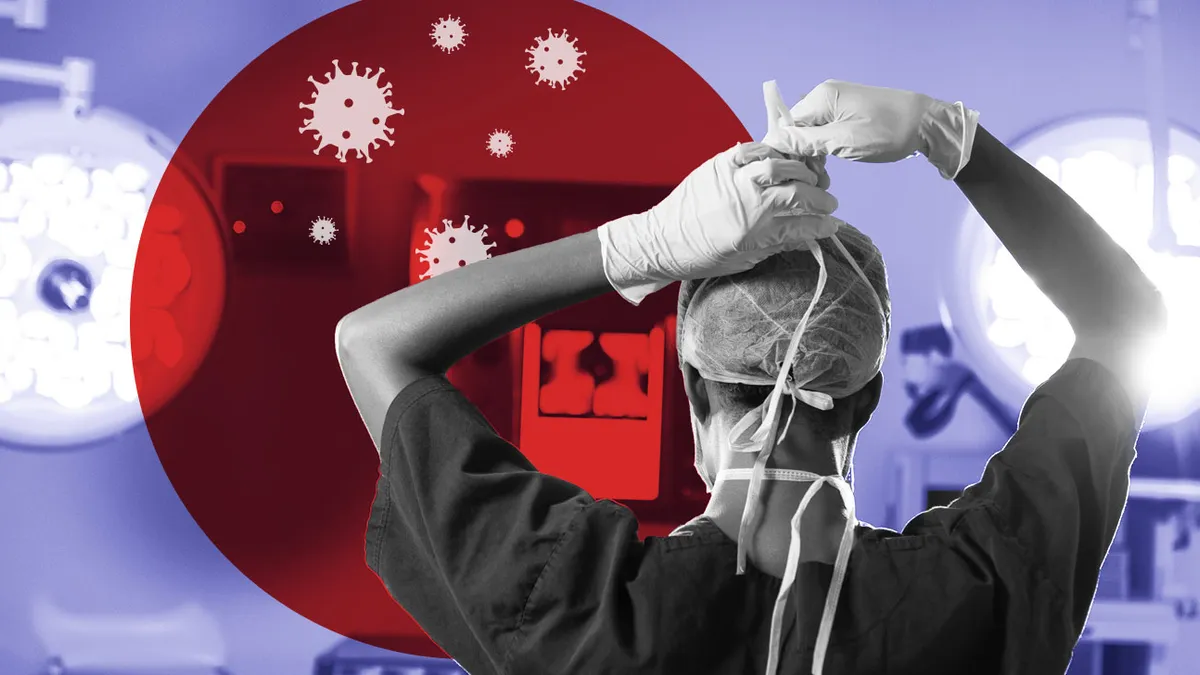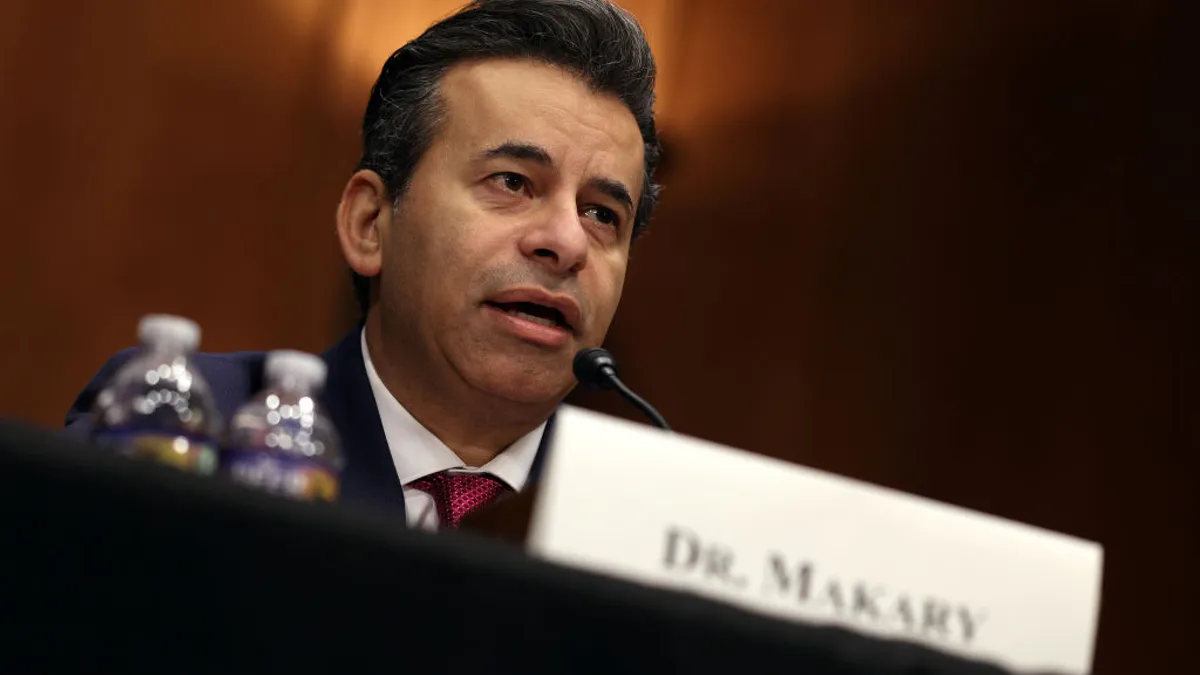This story is part of a MedTech Dive series examining the impact of the COVID-19 pandemic on the medtech industry, published six months after the U.S. declared a public health emergency. You can find the other stories here.
Several months back, many medical device makers painted a stark picture in which 50, 60 or 70% of their business dried up in a span of days, with elective surgeries largely shelved as the U.S. grappled with a pandemic few industries were prepared to handle.
But as second quarter earnings reports roll in, the sector's story is shifting.
The troughs in elective procedures seen in April moved to near-normal volumes come June, setting up device companies across the board to beat initial pandemic-era expectations. And the better-than-feared trajectory covers a number of device categories.
Cardiac device specialist Edwards Lifesciences, for example, posted a quarterly sales decline of 15% but still handily beat Wall Street estimates. The healthcare and medtech industries have decried “elective” as a misnomer, noting many are deferring important care for harmful conditions such as, in Edwards' case, aortic valve disease. But potentially less time-sensitive orthopaedic procedures are also making a noteworthy comeback.
“The surprise was just how hips, knees and orthopaedics were quicker to recover in tandem with those more emergent procedures, and in some cases, more rapidly than in other kinds of elective procedures that might even be considered more emergent in nature,” Richard Newitter, a senior research analyst at SVB Leerink covering medical supplies and devices, told MedTech Dive.
“I think a lot of that probably has to do with the fact that these are procedures that are extremely profitable to hospitals.”
Indeed, in recent reports to investors health systems including HCA and Tenet have detailed similarly devastating business impact from the springtime pullback in elective procedures.
Even with the rosier procedure upswings reported from June, in some parts of the country those trends may already be outdated, with new or worsening outbreaks in states including Texas, Florida, South Carolina and Mississippi, for example, prompting temporary countywide or hospital system restrictions again on elective surgeries. As for how exactly July shook out by comparison: "that's the big question mark," Newitter said.
Despite regional turbulence, many company execs remain optimistic that another nationwide shutdown is highly unlikely. That prediction would place the most dramatic declines in revenue in the past and put the focus on getting back to business as usual, even as prevalence of the virus keeps ticking up.
What medtechs can't control, and what they can
Whether the linked recoveries of elective surgeries and the medtech industry prove to take a sharper V-shape or a more gradual U-shape remains to be seen, thanks to a plethora of levers out of the sector’s control.
For foot and ankle surgeon Brett Sachs, based in Colorado, the schedule of elective surgeries has more or less been back to normal since the beginning of June, with new personal protective equipment guidelines and other COVID-19 precautions in place.
Even with procedures allowed, Sachs has seen firsthand how pandemic-driven job losses have reduced access to those surgeries. The U.S. unemployment rate was 11.1% in June, with millions of people out of job-based health insurance.
“There's a lot of my particular patients who have been out of work for a period of time or furloughed,” Sachs said in an interview, “so the cost of treatment and even just basic office visits have been a challenge for some patients.” That in and of itself has had “a tremendous impact” on surgery schedules, he said.
Unlike some healthcare practices particularly in the South and West, Sachs has not experienced another freeze to procedures since they were allowed to restart in Colorado in May. But the possibility is on his mind.
“My schedule is relatively predictable although I am worried about surgeries getting canceled,” Sachs said. “The numbers here in Colorado are definitely going up. I wouldn't be surprised if that restriction starts to be discussed again.”
Perhaps a greater risk to a sector recovery is that those outbreaks spook consumers from seeking procedures. The healthcare and medtech industries have aligned interests in those patients returning to care and are making investments accordingly.
Johnson & Johnson CFO Joseph Wolk said on a July 16 earnings call the company is "developing programs to alleviate patient concerns related to elective surgeries and procedures as well as helping the overall industry treat patients with new public education materials and resources that increase patient confidence and inspire people to prioritize their health."
That effort follows a TV, print and social media campaign launched earlier this month by LabCorp, McKesson, the American Heart Association and a number of other healthcare partners encouraging Americans to "Stop Medical Distancing."
Now is an optimal time for medtech companies to increase their direct-to-consumer marketing, building on a trend that's grown in recent years, according to Jay Zhu, who leads the Medtech Commercial Strategy practice at Deloitte. For the last four years or so, companies like Boston Scientific, Exact Sciences and Abbott have stepped up their TV commercials, Zhu noted.
"To increase the patient population is a critical revenue driver," Zhu told MedTech Dive.
While the pace at which those patients return may vary across the country, hospitals want to be prepared to service all elective business that comes their way.
That means having the necessary PPE and testing devices in place to cover demand for procedures, as well as greater inventory on hand than may have previously been desired, said Monish Rajpal, a partner at L.E.K. Consulting who focuses on medtech, healthcare and biopharma.
"You are seeing a little bit more of a stock-up that's occurring across a number of different product categories. But at the same time, their finances are [hurt.] Hospitals are leaning on their suppliers to come up with creative ways of supporting them," including providing supply guarantees, cost alleviation strategies, or adjusting payment times, he said.
"A lot of those requests are coming through from hospitals to suppliers as they try to deal with the fact they have a financial crisis on their hands, they have a lot of needy patients that need to be taken care of, and they have to do it under the ongoing threat of infection."
Leveraging outpatient facilities
The continued need to secure PPE and testing to make more procedures possible is being felt not just at hospitals but at ambulatory surgery centers. The outpatient facilities have taken on more orthopaedic and cardiology procedures in recent years, making them an increasingly important business partner for device companies.
When Texas reimposed elective surgery restrictions on hospitals at the end of June in response to a rapid crowding of beds with COVID-19 patients, ASCs were exempt, giving them more freedom to continue with scheduled procedures.
Kimberly Persley, a practicing gastroenterologist in Dallas and president of the Texas Ambulatory Surgery Center Society, said the ASC where she performs 90% of her procedures started the year very busy. In April, procedures fell to about 6% of typical volumes, but by June, that figure was up to 80%. Centers aren't yet at full capacity; they still have the opportunity to take on more business.
California saw a similar trend. Early in the U.S. shutdown, surgery centers closed or were doing just 10% of normal volumes, said Beth LaBouyer, executive director of the California Ambulatory Surgery Association. While the state's current procedure levels vary geographically, on average they're back to about two-thirds of typical business, she said. But there's not clear visibility into how much ASC business is COVID-19 backlog, and how much may be newly generated through telemedicine consultations, she added.
Similar to hospital and medtech efforts to encourage patients to prioritize important delayed care and advertise their safety measures, ASCs and their referring doctors are doing the same, while delineating how they differ from a hospital. In the wake of the pandemic, many of them don't have to worry about balancing COVID-19 patients the way hospitals do may increase patients interest, in turn boosting the prospects of the medtechs that supply them.
Some procedures are just better suited for a hospital, Persley said, but for the ones that don't necessitate it, this could be a tipping point for familiarizing patients with ASCs.
"I have patients who have always been a little reluctant or resistant to have something outside of a hospital, but their fear of COVID coming to a hospital has really opened them up to a new experience," she said.
Overall, communication between hospitals, ASCs, device makers, doctors and patients as procedures again ramp up has room for improvement, Persley said. "This whole health crisis, the approach has been so fragmented."





















